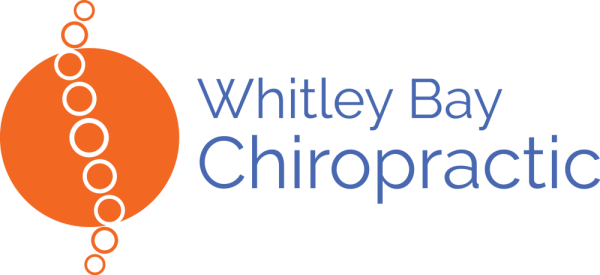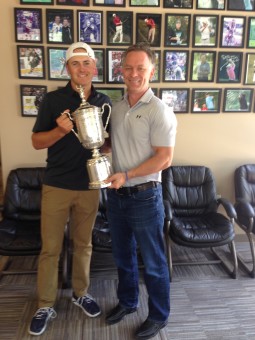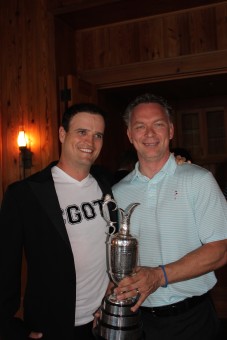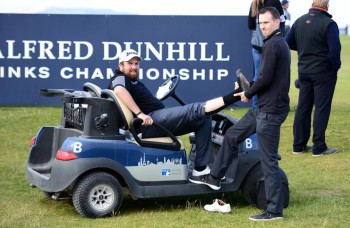Golf Training and Therapy
A behind the scenes look at how professional golfers like Jordan Spieth and Shane Lowry maximize their athleticism, and some tips for how average golfers can improve theirs.
Improving biomechanics with golf training!
The name of the game in modern golf training is improving athleticism. Tour players now work harder and very importantly smarter than ever on their fitness and strength training. They use the high tech video analysis to find swing faults that the naked eye can’t detect. Most of the top golfers in the world tour with a team of experts who use the information gleaned from this technology and other tests to develop a training and therapy regime to address any biomechanical issues found. Rory McIlroy is one of many players who have embraced this philosophy as the following quote clearly shows.
“I started to work on my fitness and strength for injury prevention and biomechanical standpoint. I got biomechanically analyzed in 2011 and we saw my peak club head speed was 18 inches before impact, my club was slowing down before I hit the ball. That was because I basically had no stability in my hips, my glutes, and my legs, especially on my left side, so a lot of stability work on my legs and my core and legs. I’ve always been able to create speed, but haven’t always been able to hold onto it through impact. .. I am always doing lower body work on a wobble cushion or BOSU ball, I’m doing a lot of single leg work. I’ve always had the ability to turn my hips fast and to have that explosive power, but if I’m not able to hold on to it or control it then either the ball is going to go all over the place or I’m not going to be able to control it” Rory McIlroy video from Me and My Golf
If you’re not assessing, you’re just guessing
A new paradigm has emerged in golf training, it involves biomechanical analysis of the golf swing and much more. In addition to high tech swing analysis, players are given a full body movement screen which tests flexibility, balance, stability, and coordination. A bespoke training and therapy regime is created using the findings to improve a player’s mechanical issues, weaknesses, and negative tendencies. One company that is at the forefront of this paradigm is Titleist Performance Institute (TPI). They put an emphasis on players improving movement fundamentals of mobility, coordination, and balance, and only when these fundamentals are mastered does strength, endurance, power, and skill acquisition become the focus of training. One player who uses a team full of TPI experts is world number one Jordan Spieth.
Spieth is under the care of TPI Chiropractor Troy Van Biezen on tour, who also looks after Zach Johnson, Jason Dufner, and Rickie Fowler. Van Biezen told me, “Each player has individual tendencies and imbalances that are checked every morning and addressed to stay on top of them. After the round, corrective based exercises are employed.” One example where Spieth’s team used swing analysis technology , therapy, and training together occurred when his coach, Cameron McCormick, noticed a tendency for him to sway when swinging. McCormick then asked Van Biezen and Spieth’s trainer to focus on increasing Spieth’s hip mobility. Van Biezen said, “The soft tissue component is crucial, imbalances and dysfunctions need to be addressed.” The system must be yielding results as the group of players he treats on tour are winning majors and are at the top of the world rankings.
The importance of reducing soft tissue restrictions
In many cases, tailored exercises can improve imbalances but some soft tissue and joint restrictions are harder to shift. Many of the best golfers in the world including Van Biezen use Active Release Techniques® (ART) providers it the market leading soft tissue therapy in the world. The technique involves a patient shortening a muscle, the ART provider applies tension to the muscle with his/her fingers. The patient then stretches the muscle, pulling the muscle under the provider’s contact. The manual tension combined with the movement of the muscle improves flexibility immediately. Golfers who aren’t naturally athletic often need to work on soft tissue and joint flexibility.
Prefer an at home solution? Try foam rolling!
Foam rolling has grown massively in popularity over the last few years, and now even researchers have backed up the word of mouth evidence. Researchers may not know why it works, or exactly how long to roll, but they’ve found it does reduce pain and increase flexibility. The areas were foam rolling is particularly effective in increase increasing flexibility are the mid-back, hamstrings, and calves. Researchers found a short session of static stretching followed by foam rolling to be more than doing only one or the other. Stay off bony bits, and away from the top lateral side of the calf (to avoid a superficial nerve there).
Van Biezen with Jordan Spieth and Zach Johnson celebrating major victories!
“Troy Van Biezen has been an integral member of my team since high school, I trust him fully and he now tours with me. Chiropractic care with a goal of achieving better postural balance and injury prevention, has been invaluable to my health, performance, and success.” Jordan Spieth World #1
How to take the pressure off of the lower back
Lower back pain in golfers is an example where addressing the problem is often best served by improving flexibility. “If the mid-back and hips are not rotating enough the lumbar spine may compensate and the lumbar spine is not designed for a great deal of rotation”, says TPI / ART Chiropractor Shane Lawlor who has spent many years on tour with the likes of Shane Lowry and Padraig Harrington. “Some of the mistakes that I see amateur & professional golfers make is a poor warm up routine and not investing enough in hands on therapy. The biggest downfall is that they neglect to build a team around them. All of these contribute heavily to the common injuries experienced in the sport.”
Photo golffile.photoshelter.com
“Shane is an integral part of my performance team and he has definitely added to my game over the past 3 years. His combined skills of Chiropractic & ART ensure that I am prepared physically for each round I play. I believe working with Shane is helping me to prevent injuries and will hopefully lengthen my career.” Shane Lowry
How can recreational golfers train smarter and prevent lower back pain?
The average hacker has the same flexibility problems as the professionals, only worse in most cases. If you feel your flexibility or balance is holding your golf training seek out a TPI professional who works with an ART soft tissue specialist. If that isn’t possible, here are some tips to find your imbalances so you can train them away. It is often wise to work the weaker side more often until both sides are even and then go back to more traditional exercises like deadlifts and squats. Always train at a level that is safe for you, these exercises should be mastered at an easier level before made more difficult.
https://www.youtube.com/watch?v=Eqw1vuzXsjk
Articles I wrote or contributed to:
Telegraph The ART of Active Release Techniques for Injuries
STACK New Age of Golf Training is Creating Stronger and More Athletic Golfers
Athletics Weekly Performance Therapy for Greg Rutherford
220 Triathlon ART- How is it different from sports massage
Vigour Magazine ART can release tight muscles to improve performance
Progenex ART for CrossFitters
FIT Institute Research based hamstring therapies
TPI What Performance Therapy Looks Like For Top Golfers



